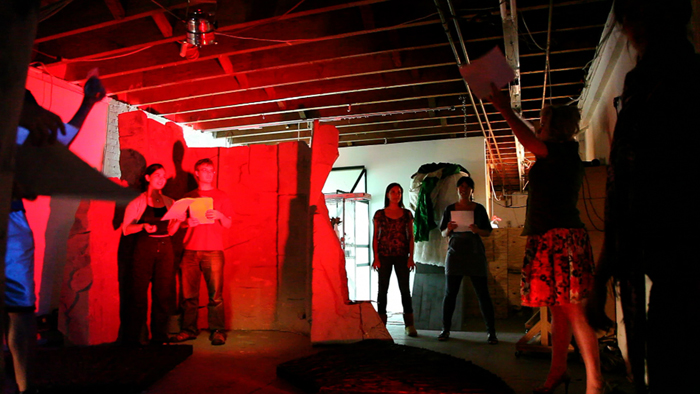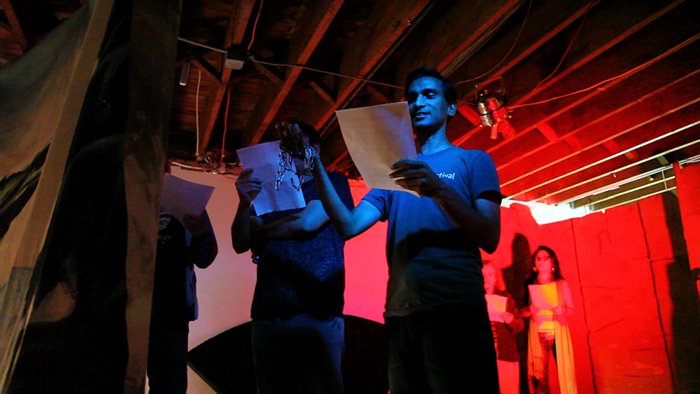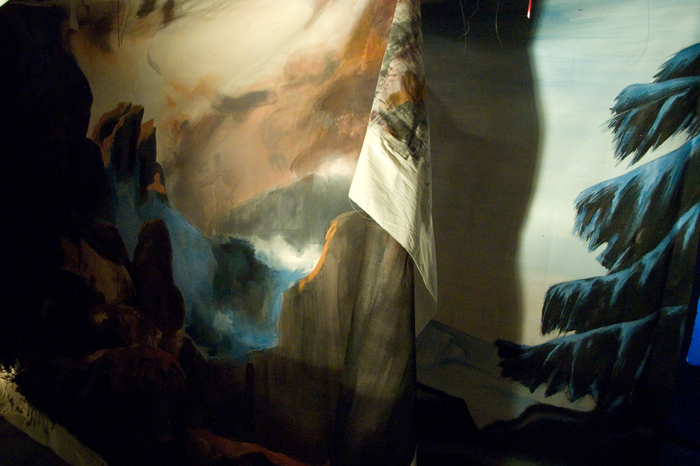Three green beanbag chairs are stacked—one atop the other two—in front of a live video feed projected onto a typically white gallery wall. The beanbags form an arrow that points directly towards the footage. Taking a seat means becoming an act of sorts, acting, or rather, activating the scene. Press the green play button; we’re rolling. An unfamiliar voice asks, “Who wants to be Siegmund?” Raising my hand to say “I’ll do it,” feels more like a tic than a conscious decision; it’s only in hearing my own voice that my hand becomes mine.
“Having taken his seat, the spectator now finds himself in a veritable theatron, in other words, in a space that exists for no other purpose than for looking, and looking, moreover, in the direction in which his seat points him.”1
Liz Glynn’s installation, Basement Wagner: A Brief History of the Bayreuther Festspiele, opens as a setting for a collaborative performance project by Glynn and Juliana Snapper. Walking through Wagner asks volunteers to act out the complete stage directions for Der Ring des Nibelungen. The show begins a series of events at Machine Project in conjunction with the Ring Festival LA, which is described on its website as the first city-wide arts festival since the 1984 Olympics. The centerpiece of the Ring Festival is the LA Opera’s staging of Richard Wagner’s entire four-opera cycle for the first time in Los Angeles history. But don’t come to Machine expecting to hear the music.

Liz Glynn and Julianna Snapper, Basement Wagner, June 2010. Mixed media installation based on historic sets from the Bayreuther Festspiele with performances based on Wagner’s complete stage directions for The Ring Cycle. Courtesy of the artists, Machine Project, and Redling Fine Art. Photo: Emily Lacy.
I am handed a script, along with a list of eight performance instructions and an illustration explaining the layout of the basement installation. I flip through the materials. The script, a copy of Wagner’s Die Walküre, has all of the sung parts blacked out—leaving only the stage directions and character names. Glynn and Snapper’s instructions include: “Action is requested, but no acting is necessary. You may choose to embody emotion, but this is at your discretion. Please be advised that many of the stage directions involve physical contact with other players. If you decide to take the score, please be willing to engage.”
Other volunteer-actors and I are assembled and guided past the beanbags to the back of the gallery, where a staircase leads us down to the basement. At the foot of the stairs, a large, open ice chest contains an array of objects. A sign above it reads: “PROPS.” Inside, an ordinary sledge hammer, claw hammer, flashlight, shovel, and mop chill next to a makeshift wooden sword and torch. Tree branches, which later double as walking sticks and spears, are there too. Walking past the cooler onto an arrangement of four slightly raised black wood planks, we are center stage, in front of the camera and fully immersed in the installation. Our bodies activate the set, sharing the narrative space with a tall Styrofoam cliff, a small corner stone boulder and two hand-painted backdrops. One, made of canvas, depicts a mostly vertical mountain-scape in the distance rendered in warm hues; the other, painted on a humble bed sheet, uses primarily cool hues to depict a jagged horizontal cliff in the foreground of an open sky. As indicated in the layout illustration, these elements are taken from various pivotal stagings of the Ring Cycle at the Bayreuther Festspielhaus in Bayreuth, Germany, an opera house built for and dedicated to showing only Wagner’s operas. Glynn appropriates elements from a precise 100-year span, starting with Wagner’s 1876 staging and ending with Patrice Chéreau’s controversial centennial adaptation. All of these elements, along with our own action/acting bodies, are projected in silence and viewed both in the gallery space above and on the web at ustream.tv.
It takes approximately forty-five minutes to walk through each of Wagner’s four operas. Glynn and Snapper take turns reading the stage directions while we “players” interact with each other, the Wagner texts, and the various elements of Glynn’s installation. Stripped of their original musical context, our actions amount to the continual erasure and condensation of performed gestures. After each opera is enacted, a break is taken and volunteers are given the opportunity to assume new character roles for the next performance. It is a night of fun and community learning. As usual, Machine Project’s goal “to make rarefied knowledge accessible”2 is accomplished through no-pressure participation.

Liz Glynn and Julianna Snapper, Basement Wagner, June 2010. Mixed media installation based on historic sets from the Bayreuther Festspiele with performances based on Wagner’s complete stage directions for The Ring Cycle. Courtesy of the artists, machine project, and Redling Fine Art. Photo: Emily Lacy.
On May 22, 1872, Wagner gave a speech in honor of the foundation stone being placed in the construction of the Festspielhaus. In his speech, he explicitly connects the purpose of the Festspielhaus to his larger theories of theater and perception, explaining how his desire to hide the “distracting” orchestra acted as a “constraint” which helped order the “total redesigning of the auditorium” and ultimately set the stage for “the truest reflection of life itself.”3 At the center of this restructuring was the repurposing of what Wagner called the “mystic abyss”—the empty space between the front row of seats and the proscenium—originally designed to symbolically and spatially separate the real from the ideal. At the Festspielhaus, a second, wider proscenium extending closer to the audience was built. Between it and the original proscenium the orchestra was buried, so to speak, “promis[ing] the most wonderful illusion that makes the actual events onstage appear to be further away, persuading the spectator to think that the action is very remote, while allowing him to observe that action with the clarity of actual proximity. In turn this gives rise to a second illusion, allowing the figures onstage to appear to be of larger, superhuman size.”4 All of this, combined with the music “rising up spectrally from the ‘mystic abyss’” grounded the Ring Cycle at the Festspiele structurally and conceptually for years to come.
Using Wagner’s notion of the “mystic abyss,” we might better understand the structural play between audience and actors in Glynn and Snapper’s participatory performance. Through their play on basement-as-foundation and camera-as-perception, Glynn and Snapper create a visual metaphor that undulates between the spatial and social, escorting viewers-cum-actors-cum-viewers playfully through a historical timeline of Wagnerian signification. We might consider this a claim against art’s ideal representational value in favor of a Brechtian shared social space where new forms of technology and community foreground the necessarily representational modes of contemporaneity. We see that “the truest reflection of life itself” cannot be defined outside of specific socio-historic contexts.
If there was one almost pitfall to the evening, it was the impulse I felt towards relegating Glynn’s installation entirely to the world of community play. Low-budget props and sets, combined with low lighting and action-based participation, seemed to request that the viewers act not only without speaking, but also without looking, as if the “viewing” of Glynn’s art ought to happen through a process devoted solely to blithe play. The problem with such an approach is that it rejects the value of the formal art object entirely in favor of some ideal aesthetic social interaction. Understandably, we are living in a participatory art world, and both Machine Project and Glynn have a strong track record of favoring the social context over the formal object. However, we ought not understand Glynn’s installation as merely a facilitation of such interactions. Glynn sculpts beautifully formal DIY wood and Styrofoam objects that are conscious of their own fragility—in terms of material ephemerality as well as vulnerability of being overlooked as significant objects. It is precisely in this ambiguous space that Glynn posits her work; in doing so she continues to create exciting projects.

Liz Glynn, Basement Wagner, June 2010. Mixed media installation based on historic sets from the Bayreuther Festspiele. Courtesy of Machine Project, and Redling Fine Art. Photo: Liz Glynn.
In his essay “We Are Too Many” Massimiliano Gioni clearly addresses today’s artists and their attempts to navigate the line between object-centered and participatory aesthetics.5 He says, “The object and the artwork are not the residual result of an action. Instead it is the object that triggers an action—the action unfolds from the object, not vice versa. As a formula, we might say that today’s artists seem to be interested in inverting the slogan of process art: not attitudes that become forms, but forms that become attitudes.”6 Thus we can understand Basement Wagner as such: Glynn’s installation is comprised of several art objects; these objects trigger action in the collaborative performance; the artwork itself is neither simply the objects nor simply the performance, but rather a complex web of all of these signifiers. Gioni goes on to say that these artists double “as directors of performances and situations that unfold inside their works or make use of their works as sets or props…result[ing] in an intriguing form of lived-in art.”7 Although it seems to place dangerous weight on the progressive flow from object to performance to “lived-in art(work)”—a premise that fallaciously values the object solely for its performative, and implicitly more inclusively real, functions— Gioni’s articulation is helpful in understanding the multiple orders of signification that Glynn is comfortably capable of in/externalizing in her artwork. Thus we might say that in her art practice, Glynn seamlessly addresses notions of object relations within broader social relations, which themselves become represented objects for others to interpret, and so on, and so on. She does so not in an attempt to favor (necessarily) one over the other, but rather to present what authors Vanessa Place and Robert Fitterman call “The Sobject [or] the properly melancholic contemporary entity.”8 Their neologism, although never explicitly defined, is an attempt to understand existence in a post-Cartesian world where bodies (objects) and minds (subjects) cannot be separated and where “only the concept ‘is’ (e.g. materiality or other invocation) is permanent.”9
Thus, through Gioni and Place/ Fitterman’s analysis, we see that Glynn works in “a perpetual procedural loop”10 of signification exploding the (absolute) metaphoric distinction between subject and object in favor of metonymic chains. Revisiting the installation days after the performance, I sit alone in Machine Project’s basement. I realize that “props” functions as both noun and verb. I see a tree sculpture that I overlooked the other evening. It exists in the corner or perhaps backstage—its brown plywood base and papier-mâché trunk support several large branches growing upwards and outwards. I experience multiple histories of “tree” in the form of the wood and paper and bark, and see a lovely play on words connecting the age of the tree sculpture to the various Ring Cycle productions incorporated in the project. I begin to connect the insulated cooler that houses the props to the Styrofoam insulation used in the mountain sculpture. The painted sheet hangs adjacent to the painted rock and I recognize the concatenation as a pun on painted sheetrock, and I am back in a home basement once again.

Liz Glynn, Basement Wagner, June 2010. Mixed media installation based on historic sets from the Bayreuther Festspiele. Courtesy of Machine Project, and Redling Fine Art. Photo: Liz Glynn.
I notice a small negative-space trapezoid stenciled in white spray paint directly onto the grey concrete floor. The shape at first seems to be accidental. Perhaps a trace of typically sloppy basement use. However, its upper left corner is meticulously aligned with the pre-existing expansion joint in the floor.
This relationship points towards an absent void positioned at the center of Glynn’s fragmented floor pieces, revealing a mapping of sorts and superbly locating all of her notions of space and materials and concepts and histories and language within an abyss itself. Embedded within these shapes is the entire potential signification tracing back to the physical cornerstone placed in the Festspielhaus.
Through Glynn’s installation we see the concrete form of the “mystic abyss.” We unbury Wagner’s orchestra pit, expanding it to see the very shape of perspective. We consider how ideas, productions, and media evolve over time. Glynn issues a powerful call to view not only a stage set but also our own set of blind spots within reconstructed histories and contemporary aesthetics. It is a pleasure to do so.
Jon Rutzmoser is an artist, writer, and educator who lives in LA. He visits Machine regularly.
